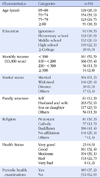Abstract
Purpose
This study was carried out to investigate relations among daily livingabilities, self-efficacy, and Yangsaegn behavior, and influencing factors on Yangsaeng behavior among elderly men.
Methods
Data were collected from 497 male elders in the D metropolitan city. Research tools included ADL, IADL, and the scale for self-efficacy and Yangsaeng behavior. The data were analyzed using frequency analysis, average and standard deviation, t-test, One-way ANOVA, Pearson's correlation coefficients, and multiple regression analysis with the SPSS/WIN 19.0 program.
Results
The subjects' ADL score was 2.86, their IADL score of subjects 2.66 out of 3, and their self-efficacy score was 2.68 out of 4, and their Yangsaeng behavior score 3.46 out of 5. There were significant differences in Yangsaeng behavior among the subjects due to age, education level, monthly income, marital status, family structure, religion, health status, andperiodic health examination. There were significant positive correlations among ADL, IADL, self-efficacy, and Yangsaeng behavior. According to the research, influencing factors on Yangseng behavior in elderly men included self-efficacy, health status, ADL, education level, IADL, and family structure.
Figures and Tables
References
1. Cha NH. A study on Yangsaeng in Korean elders. J Korean Acad Community Health Nurs. 2010. 21(3):293–302.

2. Cheon EY. Effects of ADL, self-efficacy and social support on life satisfaction in elders with visual liss. J Korean Gerontol Nurs. 2005. 7(2):195–204.
3. Choi EK. Relationship between actual health and Yangseng of the elderly in urbanites. 2004. Iksan: Wonkwang University;Unpublished master's thesis.
4. Jung HY, Park HS, Park SY. A study on Yangsaeng for health promotion of aged women in rural area. J Korean Acad Community Health Nurs. 2009. 20(1):49–58.
5. Jung YH. The life expectancy and health-adjusted life expectancy of Koreans. Health Welf Policy Forum. 2012. 193:5–18.
6. Katz S, Ford AB, Moskowitz W, Jackson BA, Jaffe MW. Studies of illness in the aged. The index of ADL: A standardized measure of biological and psychosocial function. JAMA. 1963. 185(12):914–919.
7. Kim AJ. Development of a tool in measuring Yangsaeng. 2004. Seoul: Ewha Womans University;Unpublished doctoral dissertation.
8. Kim JN, Shin YS, Khang MS, Khang YS, Kho YA, Kwon YH, et al. Community Health Nursing. 2011. Seoul: Soomoonsa Publishing.
9. Kim KS, Lee EJ. Relation between leisure sports' activities among older adults on activities of daily living andsuccessful aging. J Korea Contents Assoc. 2009. 10(4):424–432.
10. Kim MS. The effect of self efficacy and self esteem on the mental health of rural elderly. J Korean Acad Public Health Nurs. 2007. 21(2):146–157.
11. Kim SY. A study of factors influencing health promotion behavior in elderly people: Self efficacy, social support and depression. J Korean Gerontol Nurs. 2003. 5(2):171–181.
12. Lawton MP, Brody EM. Assessment of older people: Self-maintaining and instrumental activities of daily living. Gerontologist. 1969. 9(3):179–186.

13. Ministry of Health and Welfare. A national health nutrition survey. 2009. Retrieved July 23, 2011. from http://www.mohw.go.kr/.
14. Oh HS. Health promoting behaviors and quality of life of Korean women with arthritis. J Nurs Acad Soc. 1993. 23(4):617–630.

15. Park SY. A study on depression, ADl, IADL, and QOL among community-dwelling, low income elderly. J Korean Acad Public Health Nurs. 2009. 23(1):78–90.
16. Park YS, Seo DS, Kwon YH. Factors influencing Yangsaeng in elders. J Korean Acad Nurs. 2011. 41(1):72–79.
17. Pender NJ. Health promotion and nursing. Paper presented at The First International Conference of College of Nursing, Korea University, Seoul, Korea. 1999. 10.
18. Seo HM. Construction of health promoting behaviors model in elderly. 2001. Seoul: Seoul National University;Unpublished doctoral dissertation.
19. Sherer M, Maddux JE. The self-efficacy scale: Construction & validity. Psychol Rep. 1982. 51:663–667.
20. Sohn SH. Differences in cognitive function and activities of daily living between two groups without depression among patients with senile dementia. 1998. Seoul: Ewha Womans University;Unpublished master's thesis.
21. Statistic Korea. Korea social index. 2011. Retrieved July 28, 2012. from http://kostat.go.kr/portal/korea/kor_nw/2/6/5/index.board.
22. Sung JS, Park CS. Health promoting behavior and health status in the elderly. J Korean Gerontol Nurs. 2005. 7(1):71–78.
23. Walker SN, Sechrist KR, Pender NJ. The health-promoting life style profile: Development and psychometric characteristics. Nurs Res. 1987. 36(2):76–81.
24. Wang MJ. The relations among ADL, self-efficacy, physical activity and cognitive function in Korean elders. J Korean Acad Community Health Nurs. 2010. 21(1):101–109.

25. Wang MJ, Cha NH. The relations among daily life performance ability, physical activity and Yangsaeng in the elders. Poster presented at Korean Academy of Community Health Nursing, Kyung Hee University, Seoul. 2010. 06.
26. Yoo JH, Chu SK, Ban KO. The relationship between the psychosocial characteristics, family function, and activities of daily living in the elderly females. J Korean Acad Public Health Nurs. 2009. 23(1):40–49.




 PDF
PDF ePub
ePub Citation
Citation Print
Print







 XML Download
XML Download